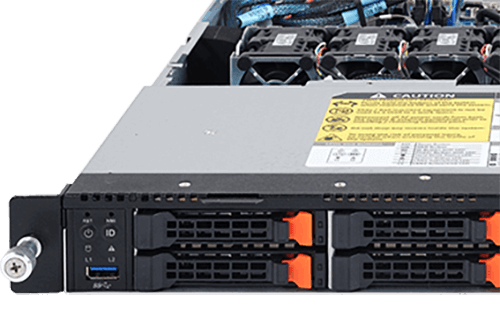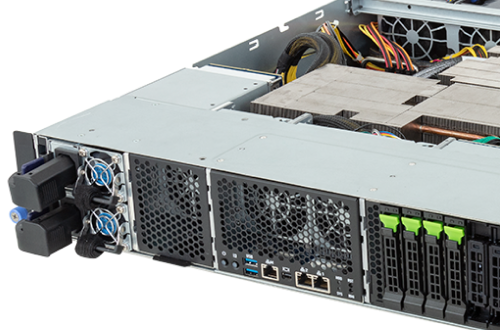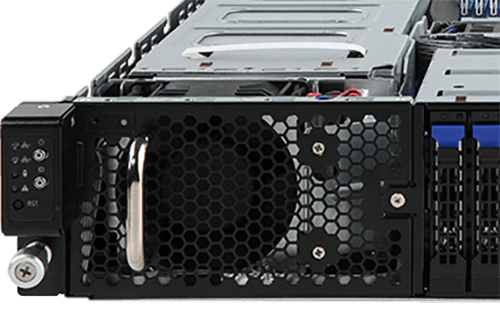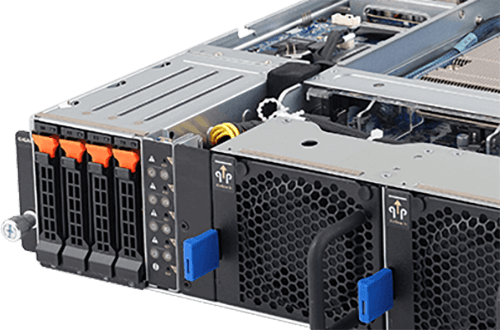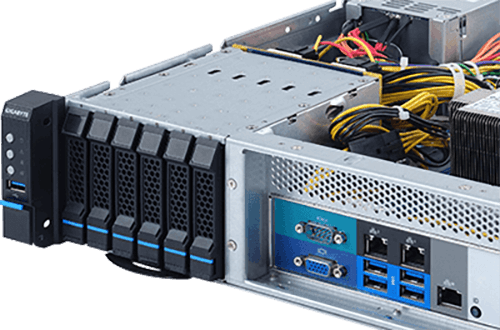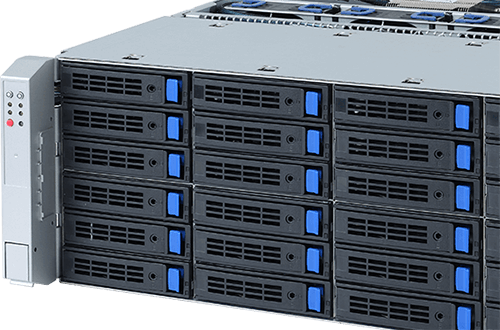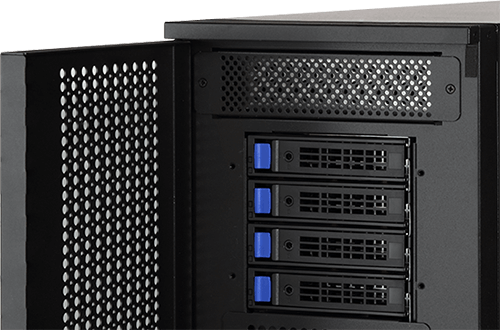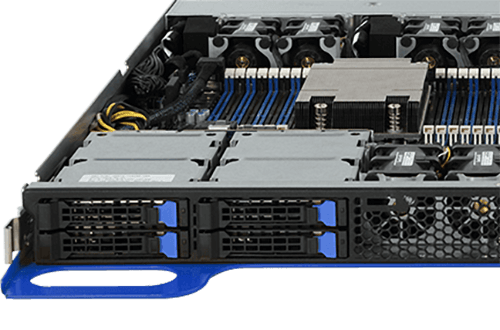Immersion Cooling
What is it?
Immersion cooling is a type of liquid cooling method where the servers are directly immersed inside a bath of non-conductive, dielectric liquid. Heat given off by the servers' components is transferred to the surrounding liquid. Because of the temperature gradient in the liquid, the heated liquid that is less dense rises to the top. As this occurs, the liquid is removed from the top of the tank and replaced with cooler liquid from the bottom. This heat transfer process is called natural convection. Therefore, the immersion cooling system does not require additional active cooling components, such as fans, and so it can go a long way toward improving your data center's energy efficiency.
There are two types of immersion cooling, which work in slightly different ways.
●Single-Phase Immersion Cooling
In this process, the coolant will not change its state by evaporating, it always remains a liquid. The warm coolant in the tank is pumped out by the coolant distribution unit (CDU) and the heat is transferred to a heat exchanger, which is a secondary cooling circuit that transfers the heat to facility water or outside air.
●Two-Phase Immersion Cooling
The cooling method in two-phase is similar to single-phase in that the coolant absorbs the heat from the servers or IT components; however, in two-phase immersion cooling, the liquid changes state. As the coolant reaches its ultra-low boiling point, the vapor bubbles rise to the top and enter a gaseous state. After evaporating, the vapor comes in contact with a condenser that returns it back to its liquid state. The fluids flow back into the bath to renew the cycle.
There are two types of immersion cooling, which work in slightly different ways.
●Single-Phase Immersion Cooling
In this process, the coolant will not change its state by evaporating, it always remains a liquid. The warm coolant in the tank is pumped out by the coolant distribution unit (CDU) and the heat is transferred to a heat exchanger, which is a secondary cooling circuit that transfers the heat to facility water or outside air.
●Two-Phase Immersion Cooling
The cooling method in two-phase is similar to single-phase in that the coolant absorbs the heat from the servers or IT components; however, in two-phase immersion cooling, the liquid changes state. As the coolant reaches its ultra-low boiling point, the vapor bubbles rise to the top and enter a gaseous state. After evaporating, the vapor comes in contact with a condenser that returns it back to its liquid state. The fluids flow back into the bath to renew the cycle.
Why do you need it?
Since routing and space for airflow found in traditional air-cooling systems do not need to be considered, servers that are ready for immersion cooling are easily modified; this allows for optimal hardware density. Cooling fans are also no longer needed, greatly reducing noise and power consumption within the data center, which in turn improves efficiency, as reflected in the power usage effectiveness (PUE) ratio. In addition, the removal of mechanical parts, such as cooling fans, means that less maintenance will be needed.
How is GIGABYTE helpful?
For single-phase immersion cooling, GIGABYTE Technology provides a complete line of solutions, including GIGABYTE's own immersion tanks for EIA or OCP-standard servers, and peripherals like lifts, dry racks, and coolants. GIGABYTE's immersion-cooled servers are also compatible with solutions from leading providers such as Asperitas, GRC, and Submer. Success cases include Japan's leading telecom provider KDDI, which used single-phase immersion cooling with GIGABYTE servers to create innovative "container-type immersion cooling small data centers" for green computing on the edge.
GIGABYTE also offers two-phase immersion cooling solutions that enable customers to significantly reduce data center energy consumption, improve PUE, and reduce operating costs and environmental impact. Success cases include the world's foremost semiconductor giant, which selected GIGABYTE’s two-phase immersion cooling solution to build "green HPC data centers" capable of pushing PUE below 1.08 and reducing the data center’s total power consumption by up to 30%.
The field of HPC, in which GIGABYTE has extensive experience, is most suitable to adopt immersion cooling due to high temperatures generated by the server components as well as high maintenance costs. GIGABYTE makes it easy to modify standard server products to be fully compatible with an immersion cooling system. The servers used in these solutions are installed with brackets to support vertical installation and removal for easy management. GIGABYTE's immersion tanks are self-contained and equipped with sensors to maintain ideal operating temperature, as well as a redundant CDU to provide greater operation stability.
Learn more:
《Advanced Cooling Solutions》
《Immersion cooling has become the top choice for ESG-centric industry forerunner》
GIGABYTE also offers two-phase immersion cooling solutions that enable customers to significantly reduce data center energy consumption, improve PUE, and reduce operating costs and environmental impact. Success cases include the world's foremost semiconductor giant, which selected GIGABYTE’s two-phase immersion cooling solution to build "green HPC data centers" capable of pushing PUE below 1.08 and reducing the data center’s total power consumption by up to 30%.
The field of HPC, in which GIGABYTE has extensive experience, is most suitable to adopt immersion cooling due to high temperatures generated by the server components as well as high maintenance costs. GIGABYTE makes it easy to modify standard server products to be fully compatible with an immersion cooling system. The servers used in these solutions are installed with brackets to support vertical installation and removal for easy management. GIGABYTE's immersion tanks are self-contained and equipped with sensors to maintain ideal operating temperature, as well as a redundant CDU to provide greater operation stability.
Learn more:
《Advanced Cooling Solutions》
《Immersion cooling has become the top choice for ESG-centric industry forerunner》
WE RECOMMEND
RELATED ARTICLES

Tech Guide
How to Pick the Right Server for AI? Part Two: Memory, Storage, and More
The proliferation of tools and services empowered by artificial intelligence has made the procurement of “AI servers” a priority for organizations big and small. In Part Two of GIGABYTE Technology’s Tech Guide on choosing an AI server, we look at six other vital components besides the CPU and GPU that can transform your server into a supercomputing powerhouse.

AI & AIoT
10 Frequently Asked Questions about Artificial Intelligence
Artificial intelligence. The world is abuzz with its name, yet how much do you know about this exciting new trend that is reshaping our world and history? Fret not, friends; GIGABYTE Technology has got you covered. Here is what you need to know about the ins and outs of AI, presented in 10 bite-sized Q and A’s that are fast to read and easy to digest!

Tech Guide
How to Pick a Cooling Solution for Your Servers? A Tech Guide by GIGABYTE
As CPUs and GPUs continue to advance, they consume more power and generate more heat. It is vital to keep temperature control in mind when purchasing servers. A good cooling solution keeps things running smoothly without hiking up the energy bill or requiring persistent maintenance. GIGABYTE Technology, an industry leader in high-performance servers, presents this Tech Guide to help you choose a suitable cooling solution. We analyze three popular options—air, liquid, immersion—and demonstrate what GIGABYTE can do for you.

Success Case
Japanese Telco Leader KDDI Invents Immersion Cooling Small Data Center with GIGABYTE
Japanese telco giant KDDI Corporation has invented a new class of data centers that are mobile and eco-friendly. These “container-type immersion cooling small data centers” employ “single-phase immersion cooling” to reduce power consumption by 43% and lower the PUE below 1.07. GIGABYTE Technology drew from its years of experience in the telco sector to provide the R282-Z93 and R182-Z91 Rack Servers for KDDI to use as the management and GPU computing nodes in the data center. KDDI benefits from the servers’ powerful 3rd Gen AMD EPYC™ CPUs, the scalable, high-density configuration of NVIDIA® GPUs in small form factors, and the servers’ optimized compatibility with the liquid-based data center cooling solution. GIGABYTE’s participation in KDDI’s project is in line with GIGABYTE’s long-term CSR and ESG efforts, which are focused on working with global industry leaders to “Upgrade Your Life” with high tech while building a greener, more sustainable environment for our future.

Success Case
Semiconductor Giant Selects GIGABYTE’s Two-Phase Immersion Cooling Solution
GIGABYTE Technology has built a “two-phase immersion cooling solution” for one of Taiwan’s foremost semiconductor giants, to be used in its sustainable, future-proof “green HPC data centers”. Not only does the solution boost the performance of HPC processors by over 10%—which is crucial for the nanometer process technology used in IC foundries—it also reduces data center power consumption by 30% and lowers PUE below 1.08, which turns it into a role model of green computing that may be replicated in data centers around the world. This exemplary project demonstrates how GIGABYTE can support its clients’ CSR, ESG, and SDGs-related initiatives, and how GIGABYTE is working tirelessly to “Upgrade Your Life” with high tech while protecting our environment.

Success Case
GIGABYTE’s GPU Servers Help Improve Oil & Gas Exploration Efficiency
GPU-accelerated servers are used in industries such as oil and gas exploration to deliver powerful computing capabilities, helping to quickly and accurately analyze large and complex data sets to reduce exploration costs. GIGABYTE uses industry-leading HPC technologies to provide customers in the oil and gas industry with GPU-accelerated servers that deliver top-tier computing performance.

Success Case
As Good as Gold – High Performance Computing Accelerates Oil Extraction
High Performance Computing (HPC) can complete complex and large-scale computational analysis workloads in a relatively short amount of time, bringing about many breakthroughs in scientific and technological development. HPC is also an indispensable tool for contemporary scientific research, and the number of fields that it can be applied to is constantly growing, such as for weather forecasting, earthquake imaging or genetic analysis. Even oil extraction can now rely on HPC to improve process efficiency and accuracy, allowing mining companies to save a huge amount of money and giving them a greater competitive advantage in the energy market.

Success Case
GIGABYTE Servers Become Part of the German Aerospace Center’s Data Center
When the German Aerospace Center (Deutsches Zentrum für Luft- und Raumfahrt, abbreviated as DLR) wanted to expand their data center, they searched for servers that could operate smoothly in an ambient temperature of 40°C without the need for air conditioning. GIGABYTE’s server team provided a solution from its High Density Server product line that combined computing, storage, and connectivity in a single system. The High Density Servers are equipped with liquid-cooling technology to run without a hitch in high-temperature environments, enabling the data center to efficiently process an enormous amount of space-related research data in the limited space available.







